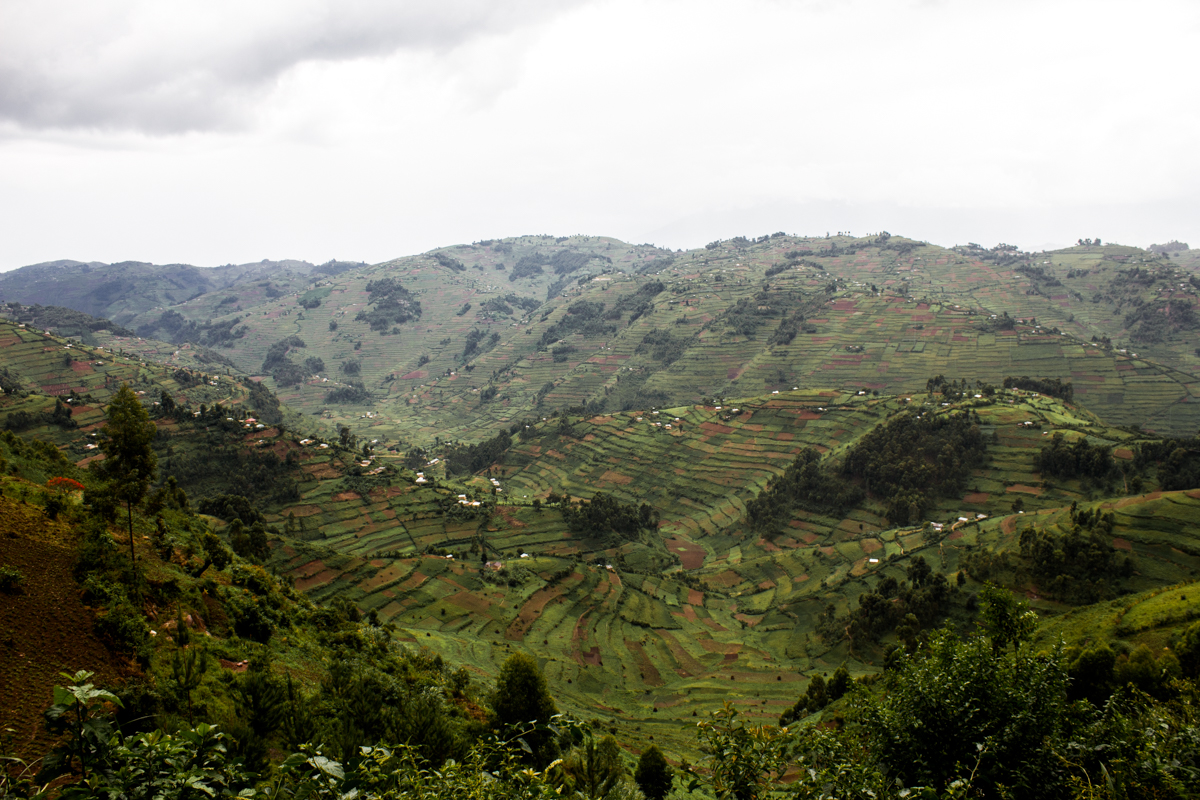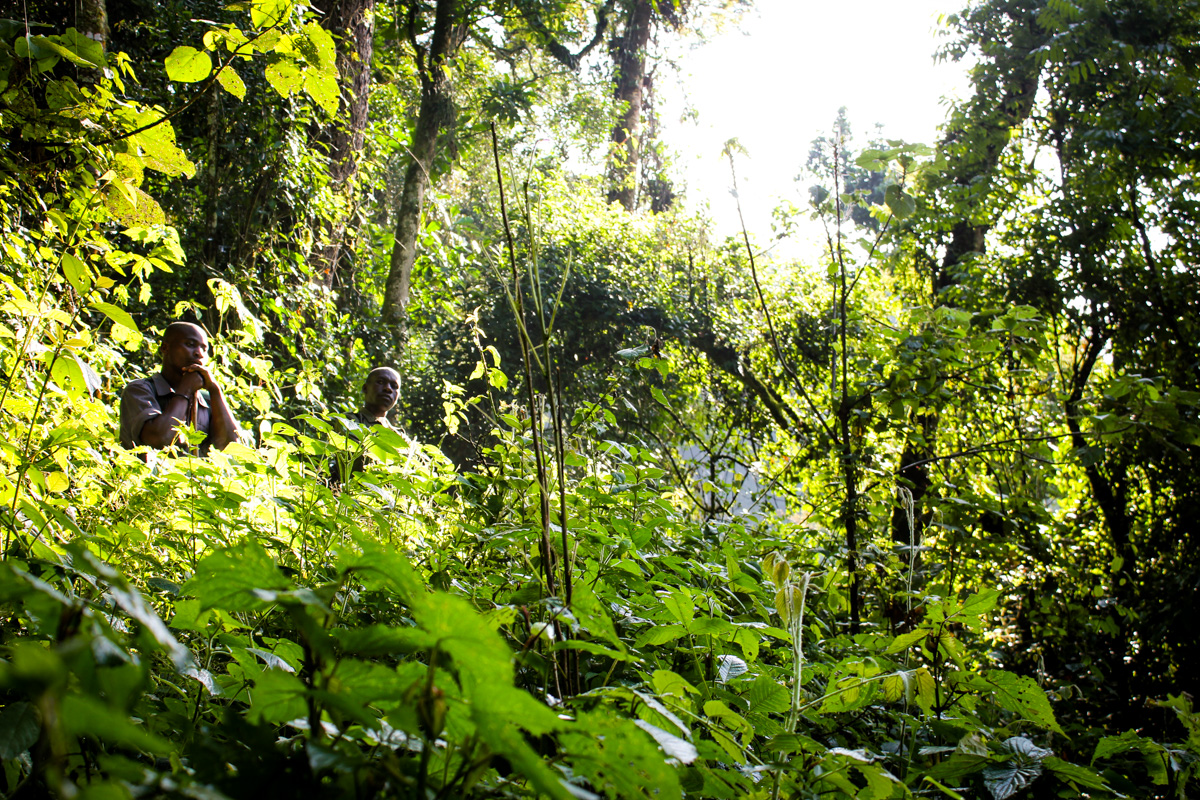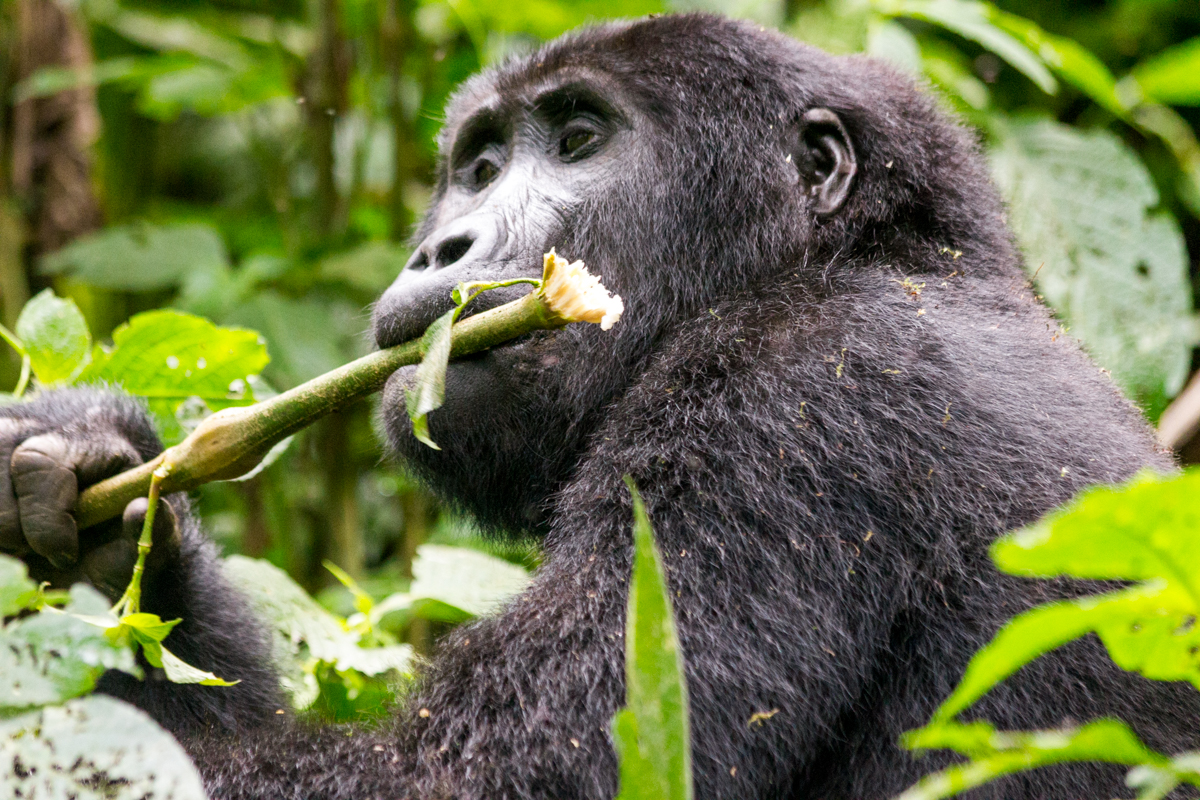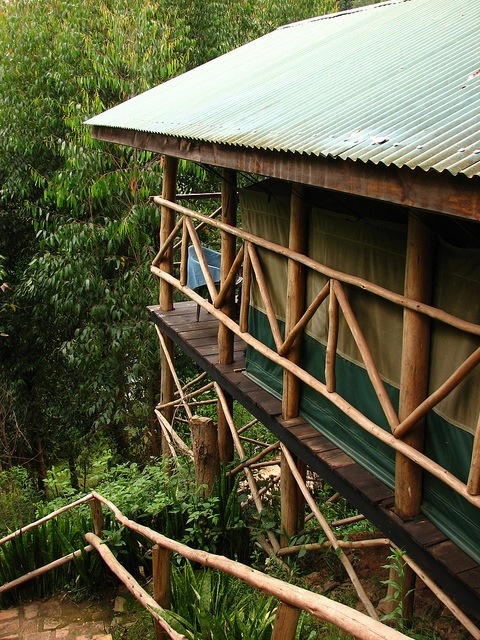
IMPENETRABLE
A journey in search of one of the planet‘s most
critically endangered species.
By JAMES MCINTOSH & TARYNNE MINGIONE
NAIROBI
Traffic was at a standstill. The honking of car horns filled the air as taxis and matutus cut across the road, fighting forward through the crowd of cars and pedestrians. Red, blue and green lights from the balconies of the night clubs above reflected off the sea of cars filling the street.
It was 7 p.m. in Nairobi and we were in a taxi on our way to the bus station to catch our overnight coach to Kampala, the capitol of Uganda.
Our driver was pissed. His right wing mirror had just been smashed off by a passing matutu and he was playing footsie with the accelerator and brake pedals – we were being thrown all over the backseat.
It took 20 minutes to go 2 kms, but we finally pulled up alongside the Queens Coach bus that would take us on our 12 hour, 600 km journey into neighboring Uganda and to the capitol city of Kampala.
The bus was surprisingly modern and clean given the rundown state of the heaving city street surrounding it. Cars whizzed by, practically running over our feet as we struggled with our bags, trying to get them into cargo hold under the bus.
With all the luggage onboard we were on our way promptly at 8 p.m. – the driver hastily navigating the packed Saturday night streets of Nairobi, furiously honking his horn.
Once outside the city our bus cut quickly through the high Kenyan flatlands, bouncing wildly over the dirt road and crashing in and out of muddy potholes.

The bus route from Nairobi, Kenya to Kampala, Uganda.
KAMPALA
The bus rolled to a stop, gently rocking us awake. It was 4:30 a.m. and we had just arrived at the Ugandan border crossing in Malaba.
We fumbled in the dark gathering our passports, visas and the remaining Kenyan money we needed to exchange into Ugandan Schillings.
The border was quiet. Our entire bus cleared immigration in less than 20 minutes and we were back on the road again before 5 a.m., hurtling our way through the night toward Kampala.
It was around 7 a.m. that I awoke briefly and looked out the window to see us crossing the Nile River. I caught a brief glimpse of a dam and a hydroelectric power plant in the grey morning light before I closed my eyes and slipped back into sleep.
With a violent lurch our bus came to a stop in the parking lot of the Oasis Shopping Mall in central Kampala.
It was 8:45 a.m.
We were 45 minutes late, but we weren’t concerned considering East African buses are some of the most dangerous in the world and we had made it to Kampala in one piece.
As we disembarked the bus we were bombarded by taxi drivers shouting in our faces, waving their car keys and making steering motions with their hands.
We quickly ducked for cover in an indoor ATM booth and withdrew 1.3 million Ugandan Schillings each. We still needed to pay for the next bus ride from Kampala to Kabale, our private driver in Kabale and the permits to track the critically endangered Mountain Gorillas.
Back outside of the ATM booth the most obnoxious, persistent taxi driver won our business and took us across town to our lodging for the evening, Red Chilli Hideaway.
The rest of our day in Kampala was uneventful.
We walked down the street about halfway into town to stretch our legs after the long bus ride, and on the way back I stopped at a barbershop to get a much needed haircut.
In the evening back at Red Chilli Hideaway we settled into a picnic table outside the bar, ate dinner and played speed while I drank a Nile Special Lager.
We called it a night early, tired from traveling the night before and weary of the eight hour bus ride we had looming the following morning.
KABALE
It was 6 a.m. and we were at the Kabale Post Office. Our bags were laid out on a tarp next to us on the floor and were being sniffed by a drug dog.
We were standing in line fighting the crowd trying to buy tickets for the once-a-day Post Bus from Kampala to Kabale.
Post Bus is a daily bus service operated by the Ugandan Postal Service. Instead of moving mail across the country in mail trucks, the postal service uses passenger coaches. The cargo hold of the coach is filled with mail and the cabin is filled with paying passengers. The buses run daily between the central post offices in most major cities, carrying passengers and delivering mail simultaneously.
These Post Buses are a far cry from luxury coaches. Our bus from Kampala to Kable was completely packed. It stopped 13 times along the way to deliver mail and drop off and pick up passengers.

The bus route from Kampala, Uganda to Kable, Uganda.

A view during the drive from Kabale, Uganda to Lake Bunyoni, Uganda.
At each stop the coach would be immediately surrounded by local entrepreneurs, shoving baskets filled with soft drinks up toward the windows, begging for business.
Other sales men actually boarded the bus toting long cababs of goat meat, dripping with marinade that splattered all over the metal bus floor.
For more than eight hours we sat shoulder to shoulder, crammed in the Post Bus with the pungent smell of body odor and two day old goat meat hanging in the stuffy air.
It wasn’t until nearly 4 p.m. that we arrived at the post office in the center of Kabale.
Kabale is essentially a one street town, reminiscent of a developing Colfax, Wash. with a dirt high street and a surplus of top heavy motorcycles.
We met up with our private driver in a small hotel across the street from the post office. He was a tall, slender man named Mike who constantly chewed on an old toothpick and drank an endless supply of Red Bull as he drove.
Our first stop after loading our belongings into Mike’s car was the grocery store to buy water and snacks for our trek into the Bwindi Impenetrable Rainforest the following day.
With our packs fully stocked Mike drove us southeast out of town down a mangled and muddy dirt track toward our campsite, Lake Bunyoni Overland Resort.
Mountainous hillsides covered with green foliage climbed steeply from the edge of Lake Bunyoni and high into the clouds.
It was significantly cooler outside than it was in Kampala, and although it was still warm there was a surprising crispness to the air that was clean and refreshing.
On our way to camp we stopped briefly on the top of a hill overlooking the lake to take in the stunning view below.

Ten minutes later we arrived at our camp positioned in the shadows of the mountains on the water’s edge. The camp was comprised of numerous open air buildings constructed from wood. A large covered restaurant and bar sat in the hillside above the water. It overlooked a small dock with deck chairs and a canoe moored to it.
To the left were small private cabins and beyond the cabins were a number of 20 foot tall wooden structures reaching high into the trees. On top of the wooden structures were wooden decks with furnished tents sitting on top of them.
As the late afternoon light began to fade we made our way down a narrow path along the hillside toward our furnished tent atop one of the wooden structures.
The inside of the tent was spacious, with a queen sized bed, two bedside tables, a telephone and a dim light hanging from the ceiling. The tent was tall enough that we both could stand up inside and move about freely.
Outside there was an area set aside with a table and two deck chairs looking out through the trees over the lake.
Before heading to dinner we stood on our deck looking out at Lake Bunyoni. The water was still and the reflection of the surrounding mountains on the surface was crystal clear.
Mike was picking us up at 5:20 a.m. the next day so we could make the two hour drive and arrive at the southern edge of the Bwindi Impenetrable Rainforest by 7:30.
After dinner we packed our gorilla tracking daypacks and went straight to bed.

The edge of the Bwindi Impenetrable Rainforest.
THE LOST WORLD
The Toyota LandCruiser hurtled through the pitch black night that blanketed the mountains surrounding Lake Bunyoni.
The SUV bounced through potholes as it followed the winding road carved out of the hillside above the lake. As we looked out the windows on the lefthand side of the car we couldn’t see anything except an endless expanse of black.
In front of us the headlights of the LandCruiser flashed over the muddy dirt road. On the right we could a rocky cliff face following the edge of the road and lifting high above us into the dark sky.
As we rocked and bounced in the back seat Mike squinted ahead, flicked on his high beams and drove onward into the night.
After more than an hour of tumbling through the darkness the sun began to rise and we soon became aware the lake and the rocky cliff face had given way to lush green rainforest.
We were still in the mountains, but descending rather quickly into a valley. Every so often a gap in the trees on the side of the road would reveal the vast equatorial rainforest surrounding us.
In the early morning light the rainforest looked like an untouched and mysterious lost world, draped in a heavy mist.
We continued our decent into the depths of the damp, humid rainforest and after another hour of driving we pulled off the dirt road into a small clearing. The clearing was surrounded by dense jungle except for a narrow footpath on one side that was visible for a few meters before disappearing up the hillside into the rainforest.
We got out of the car and Mike led us up the path into another clearing with two straw-roofed shelters in the middle. Under the the furthest shelter we met our guide who would lead us deep into rainforest in search of the Mountain Gorillas.
Our guide’s name was John. He was a thin, athletic looking Ugandan in his mid-twenties. He wore an olive green safari suit from head to toe and wielded a two foot machete as he explained to us there are only 880 Mountain Gorillas left in the world and nearly 400 of them live within 350 square km of where we stood.
After the briefing John introduced us to the rest of our expedition, three other Americans and a French couple. In all there were seven of us tracking the gorillas in addition to John and two heavily armed guards.
At exactly 8:30 a.m. our group left the clearing in a single file line and headed north along a narrow footpath into the dense foliage and towering trees of the Bwindi Impenetrable Rainforest.
THE JUNGLE
It became quickly apparent that we weren’t following a footpath. It was a game trail, and the narrow path was covered in footprints, most noticeably elephant footprints which carved out deep holes in the muddy rainforest floor.
As we moved briskly along the trail we had to carefully dodge piles of fresh elephant droppings on the ground and low hanging vine covered branches overhead.
The sun tried desperately to shine through the thick canopy of trees above us and the few rays of light that did reach the rainforest floor caused the morning mist to shimmer around us.
Birds chattered noisily in the trees and insects buzzed and hummed all around us. The sounds of the jungle were loud. There was the occasional rustle of leaves as small animals moved across the rainforest floor and up ahead we could hear the constant hacking of machetes as we cut our way deeper into the damp, humid jungle.
After about 30 minutes John made a sharp left turn off the game trail up into previously untouched vegetation. The intensity of the machete hacking increased as we carved a brand new path through the lush rainforest floor.
What started as a flat hike through the jungle soon turned into a steep climb over rocks, under fallen trees and through tangled vines. We splashed through streams and every so often our shoes sunk deep into the muddy ground.
At about 10:30 in the morning John received a call on his walkie talkie from a group of trackers that had left about an hour before us. They had found the family of gorillas we were tracking. John announced that if we kept the same pace and if the gorillas didn’t move too far we would reach them in about 45 minutes.
With renewed energy we pressed forward up the steepening mountainside and through the dense rainforest toward the family of elusive Mountain Gorillas.

Gorilla trackers, wielding machetes to cut foliage.


A gorilla in the Nshongi family in Bwindi Impenetrable Rainforest.
NSHONGI
We saw the first gorilla just after 11:30 a.m. sitting in a tree about 30 feet above the rainforest floor. She was feeding; munching recklessly on leaves and chucking the leftover branches over her shoulder.
We watched as the tree shook and branches and other debris tumbled to the ground. Our group gathered together, all of us straining our necks to get a better look at the remarkable animal perched high above our heads.
We had made it. We had tracked Mountain Gorillas in the Impenetrable Rainforest and located the Nshongi family, a close knit group of 36 gorillas.
Once the excitement of seeing our first gorilla subsided, John led us forward toward the base of the tree. As we moved closer we noticed there were actually two gorillas feeding in the trees above.
At the bottom of the tree directly below the gorillas we took our cameras out and battled with the rays of light streaming down into the jungle, trying to get a shot that wasn’t overexposed.
Tarynne and I were leading the group and standing next to John at the front of the single file line.
As everyone muddled around with their cameras one of the gorillas began to climb down the tree directly in front of us. Leaves and branches crashed to the ground as the massive creature moved gracefully toward us down the trunk of the tree.
Moments later the gorilla hopped playfully to ground literally two feet from Tarynne. The beautiful animal bounded passed us, almost touching Tarynne’s leg, before scampering off into a cobweb of tangled vines.
Still in shock over the fact a Mountain Gorilla almost just ran Tarynne over, John pushed us forward toward the vines where the animal had disappeared.
John then took the lead and with his machete drawn began to cut his way into the foliage in pursuit of the gorilla. With a few last hacks our expedition burst into a small clearing where we found ourselves face to face with a female Mountain Gorilla.
She was just sitting there in a small hole dug out of the underbrush shoving leaves and branches into her mouth. She paused and sat very still when our group first came tumbling into the clearing. Her deep brown eyes studied us intently – looking from one person to the next – sizing us up.

After a few long seconds she shrugged, reached up for a branch above her head, ripped it down and continued eating. She was seemingly unaffected by our arrival.
We spent the next 30 minutes hovering around this gorgeous animal while she ate.
She moved slowly, deliberately and elegantly.
Reaching for branches, ripping them down, stuffing leaves in her mouth and chewing happily. Every once in a while she would scratch her belly or rub her head, utterly content with her late morning feast and her cozy dug out nest.
Eventually she had eaten enough and she rolled over, flopped her hand over her head and went to sleep.
With our subject asleep, we pressed on through the network of intertwined vines and up a small hill until we came across another gorilla sitting happily on a small ledge chowing down on the surrounding vegetation.





The Nshongi family of Mountain Gorillas.
After a few minutes with this gorilla we continued further into the rainforest in search of the Silverback – the alpha male whose job it is to protect the entire family.
It was only a few meters further that we caught our first glimpse of the absolutely enormous animal. He was on the other side of a thick patch of vines staring back at us curiously. John didn’t let us get any closer, but his sheer size and power was apparent, even from a distance of about 10 meters.
Due to the fact disease can pass easily between humans and gorillas, we were only allowed to observe the Nshongi family for an hour.
Our hour expired about 15 minutes after locating the Sliverback, so with our observation time up we said our farewells and began to make our way back through the rainforest and down the mountain.

RAIN
Since the trail was already forged through the dense foliage we were able to march back through the jungle at a much quicker pace.
As we trudged down the mountain every so often between gaps in the trees we could see dark, menacing clouds looming overhead.
It would be luckily if we made it back before it started to rain we thought.
With the threat of a down pour imminent John picked up the pace and forged a new, more direct path back to the game trail.
It was then we heard the first crack of thunder in the distance and felt the first splatter of rain lightly hit our heads.
About 15 minutes later we burst out of the bushes and back onto the narrow game trail.
The dark grey clouds were lower now, heavier and more menacing. Seconds later a tremendous clap of thunder boomed over head and echoed off the face of the mountains surrounding us.
And then it started.
The heavens opened and the tropical rain fell in great drenching sheets. Our visibility was suddenly limited and it was difficult to make out the game trail winding through the jungle in front of us.
We quickly pulled our rain coats from our day packs, put them on and pulled the hoods tightly over our heads.
The game trail was beginning to flood. The massive elephant footprints were turning into huge puddles and the dirt path began to transform into a river of mud.
The rain started to come down even harder, shaking the leaves around us with hammering drops.
My raincoat only lasted a few minutes before I could feel the wet rain seeping through the shoulders and beginning to drench my shirt.
Water was flowing like a river down the game tail, pouring over rocks and pooling next to tree stumps. My shoes were soaked all the way through and with each step I could feel the water being squeezed in and out of them like a sponge.
Thunder roared directly above our heads and although it didn’t seem possible the rain started to come down even harder.
It was a real tropical storm. It was raining so hard it hurt.
We had no choice but to continue on through the slashing rain, down the game trail back toward the edge of the rainforest.
Finally we saw the clearing up ahead and the two straw-roofed shelters emerged from the pouring rain. We hurried through the final few feet of rain-drenched jungle and stumbled onto the concrete floor of the first shelter.
There we waited for the rain to stop before sliding back down the trail to the dry warmth of Mike’s LandCruiser.
NAIROBI
After emerging from the rainforest soaked to the core we spent Tuesday night again in a tent over looking the still water of Lake Bunyoni.
On Wednesday morning we took the Post Bus back to Kampala and spent the night in at Red Chili Hideaway.
After a morning run through the streets of Kampala we the spent the remainder of the day drying our clothes and organizing our photos.
On Thursday evening we boarded the Queens Coach at the Oasis Mall in central Kampala and travelled through the night back to Nairobi.
IF YOU GO
While we opted to build our own itinerary from Nairobi to Bwindi Impenetrable National Park, it’s advisable to book your trip through a tour agency that specializes in travel to Africa. There are numerous reputable travel agents to choose from, so do your research. We recommend speaking with someone on the phone and getting all of your questions answered before booking.
If you decide to plan the trip on your own, here’s where to start:
NAIROBI TO KAMPALA:
Modern Coast, Easy Coach, The Guardian Coach
KAMPALA TO KABALE:
Post Bus (tickets must be purchased at the post office in Kampala)
GORILLA TRACKING PERMIT:
Permits are $600 and must be obtained through the Uganda Wildlife Authority or a local safari operator
GETTING TO THE RAINFOREST:
Work with your hotel to arrange transportation in and out of the National Park
WHERE TO STAY
There are lots of accommodation options in both Kampala and surrounding Kabale and Bwindi Impenetrable National Park. That said, we were very happy with the two places we stayed.
KAMPALA:
Red Chilli Hideaway offers simple, budget accommodation in Kampala
KABALE:
Bunyonyi Overland Resort is situated on the edge of Lake Bunyonyi outside Kabale and offers a range of budget accommodation from furnished safari tents to family cottages
